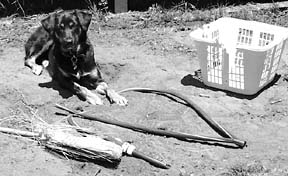A long-time dog lover, Marci Boothe volunteers at the Santa Cruz (California) SPCA walking adoption dogs. She had assumed that her landlady wouldn’t approve of her keeping a dog in her small rental unit, so she got her “dog fix” by giving love and attention to shelter dogs.
But then came Stella, a year-and-a-half-old Border Collie mix. The winsome young dog arrived at the SPCA in July of 1998. Boothe fell in love with Stella the first time she took the dog for a walk outside. Her white-and-black markings were striking, her coat was soft and silky, but it was the dog’s calm, gentle spirit and the soft look in her eyes that touched Boothe’s heart. While the majority of shelter dogs jump on their handlers in rowdy glee when removed from their kennels, Stella quietly laid down on the ground at Boothe’s feet and offered her tummy for rubbing.
“What a wonderful dog,” Boothe thought. “She’ll get adopted easily.”

However, every Friday when Boothe checked her kennel Stella was still there. Shelter staff told her that potential adopters were turned off by Stella’s mild display of defensive aggression toward other dogs.
As weeks turned into months, Booth began to worry. Although the Santa Cruz SPCA has a high adoption rate, they are an “Open Door” shelter, meaning they take in all dogs and cats in need. Sometimes, some must be euthanized. Following her fourth month at the shelter, Stella’s days were numbered. It was time to make room for other homeless dogs who deserved a chance to be adopted.
Boothe got permission from her landlady to keep a dog. She had spent more than a dozen Fridays with Stella, and knew that she loved the little dog. One October Friday, Boothe took Stella home.
A blissful first day
Boothe was confident that Stella would settle in easily, and her trust was not misplaced. Under her new owner’s close supervision Stella explored the small deck off the back of the house, then walked into the tiny living room and settled on the rug like she’d lived there all her life. She was house-trained, and showed no inclination to chew inappropriate items. Stella was home.
Boothe was jubilant. This was going to work out fine! She had deliberately adopted on a Friday so she would have the weekend to help Stella adjust. It looked like she might not even need it. As Boothe puttered around doing housework, Stella followed at her heels, staying close, always keeping her in sight. In a short time there was a close bond between the two.
The problem started the very next day. Boothe took a quick trip to the grocery store, leaving Stella in the car while she shopped. Boothe was not five feet from the car when Stella started to howl and scream. Hoping the noise would stop, Boothe kept walking. The entire time she shopped she could hear Stella crying non-stop at the top of her lungs.
And, unfortunately, it got worse. Boothe couldn’t walk down the driveway to get the mail without Stella breaking into shrill protest.
The capper came the following day, when Boothe had to return to work. At the end of that day, her landlady – who lived in the front half of the house – knocked on her door to tell Boothe, “You can’t leave that dog here during the day – she’s driving me nuts!” Boothe had to find a way to stop Stella’s screaming, fast.
Boothe started taking Stella to work with her and staying home religiously in the evenings. This prevented an immediate crisis, but she knew she couldn’t be a prisoner to Stella’s screams for the next 15 years. She had to find a solution.
That’s why, in early November, Boothe called Peaceable Paws, my dog-training business. We immediately scheduled a private in-home session to discuss separation anxiety and to begin desensitizing Stella to Boothe’s departures.
A “natural” problem
Separation anxiety is a not uncommon condition that occurs when a dog cannot tolerate being left alone. Dogs are rarely alone in their natural environment. All domestic dogs must learn to be left alone, but this is more difficult for some. Dogs who are closely bonded to their owners, who tend to be anxious anyway, or who have lost a close human companion are more likely to experience separation anxiety. A relatively high percentage of shelter dogs seem to suffer from separation anxiety, either from being abandoned by their owners and spending time in the stressful shelter environment, or because they were dumped at the shelter when their owners couldn’t deal with separation anxiety behaviors. Either way, Stella had it. Separation problems can manifest themselves in destructive behavior, house soiling, and vocalization. Booth was fortunate that Stella chose only one of the three; probably the easiest of the three to live with and correct.
I met with Boothe and Stella in early November. Stella was very bonded to Boothe, following closely on her heels from room to room. The first thing we needed to do, I explained to Boothe, was to get Stella to accept a brief separation while her beloved companion was in another room. We began by conditioning Stella to the clicker so that we could mark and reward calm behavior during Boothe’s brief absences. (That is, we clicked the clicker and fed Stella a tasty treat a dozen times or so, until she understood that every time she heard the clicker she would get a treat reward.)
Then I held Stella on her leash while Boothe stepped into the kitchen. The instant Boothe disappeared I clicked and fed Stella a treat – before she had time to take a breath to cry — and Boothe immediately returned. We repeated this several times, gradually (in half-second to one second increments) increasing the amount of time Boothe remained out of sight. When Stella was tolerating Boothe’s absence for as long as 10 seconds, I had Boothe open and close the door leading to the back deck. Stella’s anxiety level instantly increased. Several door-openings increased Stella’s stress, so we went back to brief kitchen trips, with an occasional door-opening tossed in when Stella calmly accepted the brief absences.
When Stella was relaxed about the occasional door-opening I passed the clicker to Boothe. She would have to do this by herself after I left, so we needed to set up the protocol for that now. Because the Click! is a promise that a reward is coming, it didn’t matter that when Boothe clicked it would take her several seconds to return to Stella and feed her a treat. Stella knew the treat was coming. In fact, it increased the amount of time that Stella stayed calm, because once the Click! sounded, she had several extra seconds to anticipate the arrival of the reward – and her owner.
Desensitizing takes time
We made considerable progress during the 90-minute session. Boothe was able to successfully walk out the door, across the deck and down the driveway, Click! (Stella could hear the Click! through a slightly opened window), and return. While we were nowhere near leaving Stella alone for eight hours while Boothe went to work, it was a very promising beginning. Boothe thought she would soon be able to take out the garbage and walk to the end of the driveway to get the mail without Stella turning into a screaming banshee.
The most challenging part of a desensitization program is avoiding triggering the behavior during the desensitization process. Every time the behavior is triggered it is reinforced, and becomes that much more difficult to extinguish. Most people dealing with separation anxiety don’t have the luxury of being able to gradually increase the time increments that the dog is left alone.
Fortunately for Stella, Boothe had a couple of options that many people don’t have. She could take Stella to work with her, at least for a time. And she worked nearby, with a flexible schedule that permitted her to go home every few hours when she did start leaving Stella home.
Training pays off
Boothe was persistent with her training, and the program was successful. Within two months Stella was tolerating two-hour separations like a champ. Boothe attended a Peaceable Paws Level 1 training class, which also helped to boost Stella’s confidence as well as improve the communication between dog and human.
Getting a companion for a dog with separation anxiety usually does little to ease the anxious dog’s problems. But for Stella, the final piece of the puzzle fell into place in January when Boothe’s landlady gave her permission for Stella to spend time in the back yard with her son’s Akita mix, Buff. The two dogs became fast friends, and now spend hours wrestling and tumbling together while Boothe is at work.
Boothe still doesn’t leave Stella alone for more than five hours. She doesn’t want to trigger a recurrence of the anxiety behavior. Boothe and Stella were lucky. Stella’s separation anxiety was relatively mild, and her basically calm nature was a significant factor in the positive outcome in this case. So was Boothe’s commitment to Stella. Many dogs require much more extensive desensitization programs (sometimes including drug therapy) than Stella did, and many owners aren’t as willing as Boothe to put up with difficult behaviors and do what it takes to rehabilitate a separation anxiety dog.
Expect challenges when adopting
It is almost a given that a shelter adoptee will come with some behavior challenges, no matter what. Marci Boothe did a lot of things right when she adopted Stella. She considered the adoption for a long time. She spent lots of time with Stella, as well as numerous other dogs. She evaluated the dog’s temperament for compatibility in a small granny unit apartment. She got permission from her landlady to adopt a dog, and set up a bed and toys before bringing Stella home. Yet all of Boothe’s precautions didn’t prevent her from ending up with a significant behavior problem.
Fortunately for Stella, Boothe was strongly committed to all the responsibilities of dog ownership. “The time you spend with the dog,” she says, “makes all the difference.”
-By Pat Miller





